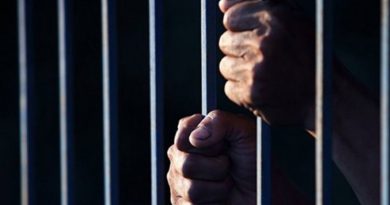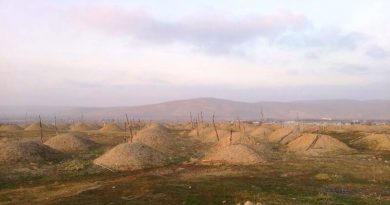Kazakhstan: Victims of torture have become the subject of manipulation
On February 13, a rally dedicated to 40 days of the January tragedy was held in Almaty. Several hundred mourners gathered in the central square of the city; according to various estimates, from 300 to 600 people. Some demanded that those responsible for torturing fellow citizens detained during the riots be punished. Others stated that the most important thing was to rename Nursultan Nazarbayev Avenue to Qańtar Avenue (January in Kazakh), and the rest demanded that the incumbent President Kassym-Jomart Tokayev be impeached. At the same time, President Tokayev was on his knees in the capital’s Khazret Sultan mosque, reading a prayer for those who died in that tragedy. And it seems that the same event was held in Almaty and Nur-Sultan – in commemoration of the victims. But the victims turned out to be different: the authorities first of all commemorated the dead policemen and security officials, and the participants in the rally – those whom the same authorities declared terrorists and looters.
“The integrity of the state, the security of citizens and the future of the country are under threat. We managed to repel the terrorists and repulsed their onslaught. Unfortunately, this turmoil claimed the lives of many citizens. This is a real tragedy. On my instructions, the relevant authorities thoroughly investigate each such case. For me, the issue of protecting human rights is very important. The unfortunate events that happened shocked the whole country. 40 days have passed since the tragic events. I came to the mosque to honor the memory of the victims with a prayer. I want to once again express my deepest condolences to the families and friends of the victims. The state will not leave you alone with trouble. I instructed to provide financial assistance to families who have suffered irreparable losses,” Kassym-Jomart Tokayev said after the memorial service in the mosque.
And on the square in Almaty near the Independence Monument at that time, people unfurled posters with the inscriptions “Stop fascism”, “Tokayev, go away!”, “We demand an independent investigation”, “Shoot to kill – words unworthy of the ruler”, “No torture!”, “The people are not terrorists, the people are not extremists”, “Freedom to the innocents”.
Many people are now talking about the torture of detainees during the January tragedy in Kazakhstan. For example, deputies of the Parliamentary Assembly of the Council of Europe (PACE) demand an international investigation and sanctions against high-ranking Kazakh officials and family members of the country’s first President, Nursultan Nazarbayev. Over the past weeks, MEPs – President of the OSCE Parliamentary Assembly (OSCE PA) Margareta Söderfelt, Chair of the OSCE PA General Committee on Democracy, Human Rights and Humanitarian Affairs Kyriakos Hadjiyanni, Chair of the Dutch Delegation of Deputies to the OSCE PA Farah Karimi – have been meeting with victims of torture and whose loved ones were killed during the riots. Among them: volunteer Timur Kim, who was severely beaten and tortured with a stun gun (accused of organizing mass riots); the wife of Anatoly Akhmetov (he is also accused of organizing mass riots), who was tortured in pre-trial detention center LA-155/18; Sayat Adilbekuly, who also became a victim torture in the same pre-trial detention center; Zhasulan Amangeldiev, who was tortured with a red-hot iron, and many others.
At the same time, no one names specific facts and figures, how many people were killed, how many were detained and how many of them are being tortured: neither the authorities, nor civil activists, nor human rights activists.
Moreover, the very fact of torture is also often a big question. On the one hand, there are testimonies of those who have been in the torture cells of the pre-trial detention center, on the other hand, assurances from the Ministry of Internal Affairs that there are no and never were any torture cells. On the third, statements by civil activists, mostly living abroad, that people are being tortured in Kazakhstan. For example, recently blogger Aizhan Khamit, who emigrated to the United States, wrote on Facebook that there is a torture cell in the pre-trial detention center LA-155/18, where “there are fasteners on the wall where people are tied, and in the same place, a saw and scissors hang on the wall.”
At the same time, there is a refutation from members of the monitoring groups who have access to correctional facilities. For example, human rights activist Zhemis Turmagambetova, in response to Aizhan Khamit’s post, wrote the following, “For about 30 years, I have been visiting and monitoring places of detention and serving sentences. Never, you know, never was and never is so.”
On the other hand, there are the revelations of Vikram Ruzakhunov, a jazzman from Kyrgyzstan, the “terrorist” who was shown on Kazakh television in a story where he admitted that he was recruited to participate in the riots in Almaty for $200. However, later, after a scandal broke out and notes of protest from Kyrgyzstan, Ruzakhunov returned to his homeland and now talks about how he was tortured. “In the cell, we were tortured so that we would give positive confessions that we had come to Almaty for the purpose of looting, rioting, robbing. Sometimes they just went into the cell and just beat. Most often, we were beaten during and after interrogation. They often took people to a separate cell and continued to beat there. The torture was different – they beat with fists, kicked all over the body, applied machine guns, beat with iron chains on the head, legs, back. They beat with a wooden mop until it shattered into pieces. They stripped people down to underpants, laid flat on stomach like a star on the dirty floor, and kicked from all sides and from above, they beat on the spine with machine guns. All this was for you to say that you were at the rally.
They made accusations that you were a murderer, you cut guys, you robbed shops. I stayed in the cell from 7 to 10 January. We were given a flatbread once; hot food was given once a day. On January 8, during one of the interrogations after the beating, we were told that they needed one person who would make a confession on camera. And then it so happened that I was taken to another cell and they said, “Either you will now say what we need, or we will continue to beat you and will not stop.” I asked what my punishment would be for that. They said that if I say everything that is necessary, then I will be deported home, and then I agreed. I asked to write everything down on paper, but they said, “Remember it so!” After several repetitions, I memorized the text. Then they brought a journalist. I asked, “What if the journalist starts asking questions not according to the script?” They answered me, “Don’t worry!” During the recording of the interview, if there were questions not according to the script, I just looked at the person off-camera. He told me what to answer and then I retold all this to the camera,” said Ruzakhunov.
In a word, the torture of participants in the January tragedy and those who didn’t take any part in the rallies, but, nevertheless, was detained, became the subject of manipulation of public opinion – both by the Kazakh authorities and by those who were tortured, as well as and those who have nothing to do with it, but pursue their own goals.
For example, the fundraising for the fight against the Kazakhstani regime has recently resumed on the website of the Foundation “Open Dialog”. The collection was opened on October 21, 2020. But after the January events, the explanatory text why the money is collected has been corrected and supplemented. Now it deals not only with the fight against the regime, but also with the support of victims of torture, the protection of political prisoners, including those detained during the January events.
At the same time, activists from Kyrgyzstan announced the fundraising to help Cholponbek Sadykov, a Kyrgyzstani who was beaten during the January riots. The police broke both his legs and ten ribs. Due to the operation, Sadykov cannot get up on his feet in the next six months.
Meanwhile, at the meeting with President Tokayev, the Prosecutor General of Kazakhstan, Gizat Nurdauletov, said that 3,070 criminal cases had been opened on the January events, 2,710 of which are being investigated by the Internal Affairs bodies – mainly theft, robbery, hooliganism, and theft of weapons.
He also said that the National Security Committee is considering 15 cases on charges of high treason, abuse of power and an attempt to seize power. The interdepartmental investigation group, led by special prosecutors, is handling 179 cases of riots and acts of terrorism. Separately, an investigation is underway in relation to officials of law enforcement agencies who left office buildings at the peak of the riots. Because of such actions in the city of Almaty, Almaty and Dzhambul regions, more than one and a half thousand weapons from the arsenals of law enforcement agencies fell into the hands of criminals.
In addition, according to the Prosecutor General, the Anti-Corruption Service of Kazakhstan is conducting 173 cases on reports from citizens about abuse of power by law enforcement officers.
President Tokayev, in turn, instructed to immediately respond to each confirmed signal of torture, taking measures of responsibility against the perpetrators, as well as timely inform the population about the progress of the investigation.




